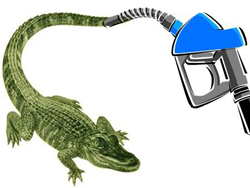 We’ve told you before about how researchers found a way to turn alligator fat into biodiesel. But this article in Biodiesel Magazine says new findings show a method using a supercritical methanol to make the scaly-sourced biodiesel even more efficiently.
We’ve told you before about how researchers found a way to turn alligator fat into biodiesel. But this article in Biodiesel Magazine says new findings show a method using a supercritical methanol to make the scaly-sourced biodiesel even more efficiently.
Researchers reported on a novel method this week at the 247th National Meeting of the American Chemical Society, to produce biodiesel from crude animal fats, including waste fat from alligators, using supercritical methanol in a flow reactor. “Conversion of animal fat to biodiesel has been around for some time, but the traditional biodiesel process generates significant quantities of solid waste,” said Thomas Junk with the University of Louisiana at Lafayette. “Our new method creates hardly any such residues.” In an earlier study, Junk used alligator fat and a batch reactor, but for his new research, a flow reactor and supercritical methanol were used. “We set up a flow reactor, and the reaction converting alligator fat to biodiesel happened within a few minutes,” said Junk. “That’s important for commercial manufacturing, where you want to produce as much fuel as quickly as possible.”
The biggest advantage to using the supercritical method is that it doesn’t require a catalyst, which creates residue. In addition, the fat doesn’t have to be extracted and can be used in its raw form. That means while gator fat could be a viable feedstock, the researchers also see a bigger application for even more plentiful animals fats, such as chicken and beef, that might otherwise be dumped into a landfill.

